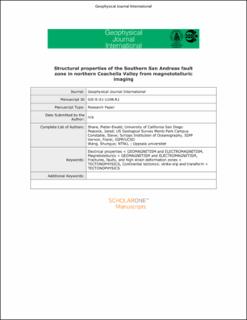| dc.contributor.author | Share, Pieter-Ewald | |
| dc.contributor.author | Peacock, Jared R. | |
| dc.contributor.author | Constable, Steven | |
| dc.contributor.author | Vernon, Frank L. | |
| dc.contributor.author | Wang, Shunguo | |
| dc.date.accessioned | 2023-02-16T14:17:23Z | |
| dc.date.available | 2023-02-16T14:17:23Z | |
| dc.date.created | 2022-09-19T11:08:53Z | |
| dc.date.issued | 2022 | |
| dc.identifier.issn | 0956-540X | |
| dc.identifier.uri | https://hdl.handle.net/11250/3051610 | |
| dc.description.abstract | The Southern San Andreas fault (SSAF) poses one of the largest seismic risks in California. Yet, there is much ambiguity regarding its deeper structural properties around Coachella Valley, in large part due to the relative paucity of everyday seismicity. Here, we image a multistranded section of the SSAF using a non-seismic method, namely magnetotelluric (MT) soundings, to help inform depth-dependent fault zone geometry, fluid content and porosity. The acquired MT data and resultant inversion models highlight a conductive column encompassing the SSAF zone that includes a 2–3 km wide vertical to steeply northeast dipping conductor down to ∼4 km depth (maximum of ∼1 Ω·m at 2 km depth) and another prominent conductor in the ductile crust (∼1 Ω·m at 12 km depth and slightly southwest of the surface SSAF). We estimate porosities of 18–44 per cent for the conductive uppermost 500 m, a 10–15 per cent porosity at 2 km depth and that small amounts (0.1–3 per cent) of interconnected hypersaline fluids produce the deeper conductor. Located northeast of this conductive region is mostly resistive crust indicating dry crystalline rock that extends down to ∼20 km in places. Most of the local seismicity is associated with this resistive region. Located farther northeast still is a conductive region at >13 km depth and separate from the one to the southwest. The imaged anomalies permit two interpretations. The SSAF zone is vertical to steeply northeast dipping in the upper crust and (1) is near vertical at greater depth creating mostly an impermeable barrier for northeast fluid migration or (2) continues to dip northeast but is relatively dry and resistive up to ∼13 km depth where it manifests as a secondary deep ductile crustal conductor. Taken together with existing knowledge, the first interpretation is more likely but more MT investigations are required. | en_US |
| dc.language.iso | eng | en_US |
| dc.publisher | Oxford University Press | en_US |
| dc.relation.uri | https://github.com/ShunguoWang/ShunguoWang.github.io/blob/master/files/NTNU/Share%20et%20al.%20-%202022%20-%20Structural%20properties%20of%20the%20Southern%20San%20Andreas%20.pdf | |
| dc.title | Structural properties of the Southern San Andreas fault zone in northern Coachella Valley from magnetotelluric imaging | en_US |
| dc.title.alternative | Structural properties of the Southern San Andreas fault zone in northern Coachella Valley from magnetotelluric imaging | en_US |
| dc.type | Peer reviewed | en_US |
| dc.type | Journal article | en_US |
| dc.description.version | acceptedVersion | en_US |
| dc.source.journal | Geophysical Journal International | en_US |
| dc.identifier.doi | 10.1093/gji/ggac356 | |
| dc.identifier.cristin | 2053003 | |
| dc.relation.project | Norges forskningsråd: 309960 | en_US |
| dc.relation.project | Norges forskningsråd: 324442 | en_US |
| dc.relation.project | Norges forskningsråd: 294404 | en_US |
| cristin.ispublished | true | |
| cristin.fulltext | postprint | |
| cristin.qualitycode | 2 | |
